Muscle Hypertrophy Training Programme
VerifiedAdded on 2023/01/11
|7
|1522
|51
AI Summary
This article discusses a muscle hypertrophy training program that focuses on improving muscle performance. It covers warm-up exercises, exercise selection, exercise order, exercise volume, exercise intensity, rest periods between sets and preps, and cool-down exercises. The program is designed to prepare the body for increased loads and improve overall physical and mental health.
Contribute Materials
Your contribution can guide someone’s learning journey. Share your
documents today.
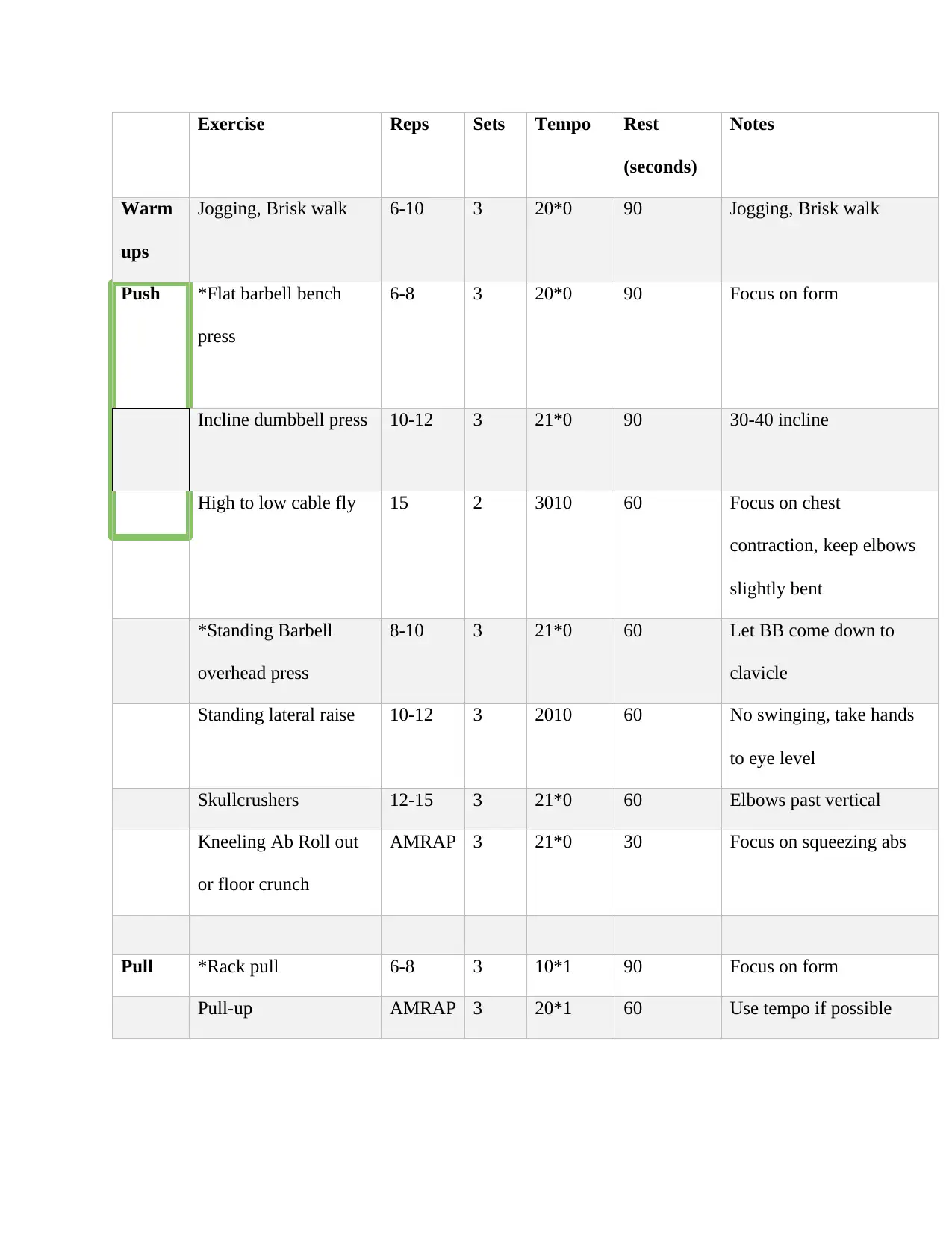
Exercise Reps Sets Tempo Rest
(seconds)
Notes
Warm
ups
Jogging, Brisk walk 6-10 3 20*0 90 Jogging, Brisk walk
Push *Flat barbell bench
press
6-8 3 20*0 90 Focus on form
Incline dumbbell press 10-12 3 21*0 90 30-40 incline
High to low cable fly 15 2 3010 60 Focus on chest
contraction, keep elbows
slightly bent
*Standing Barbell
overhead press
8-10 3 21*0 60 Let BB come down to
clavicle
Standing lateral raise 10-12 3 2010 60 No swinging, take hands
to eye level
Skullcrushers 12-15 3 21*0 60 Elbows past vertical
Kneeling Ab Roll out
or floor crunch
AMRAP 3 21*0 30 Focus on squeezing abs
Pull *Rack pull 6-8 3 10*1 90 Focus on form
Pull-up AMRAP 3 20*1 60 Use tempo if possible
(seconds)
Notes
Warm
ups
Jogging, Brisk walk 6-10 3 20*0 90 Jogging, Brisk walk
Push *Flat barbell bench
press
6-8 3 20*0 90 Focus on form
Incline dumbbell press 10-12 3 21*0 90 30-40 incline
High to low cable fly 15 2 3010 60 Focus on chest
contraction, keep elbows
slightly bent
*Standing Barbell
overhead press
8-10 3 21*0 60 Let BB come down to
clavicle
Standing lateral raise 10-12 3 2010 60 No swinging, take hands
to eye level
Skullcrushers 12-15 3 21*0 60 Elbows past vertical
Kneeling Ab Roll out
or floor crunch
AMRAP 3 21*0 30 Focus on squeezing abs
Pull *Rack pull 6-8 3 10*1 90 Focus on form
Pull-up AMRAP 3 20*1 60 Use tempo if possible
Secure Best Marks with AI Grader
Need help grading? Try our AI Grader for instant feedback on your assignments.
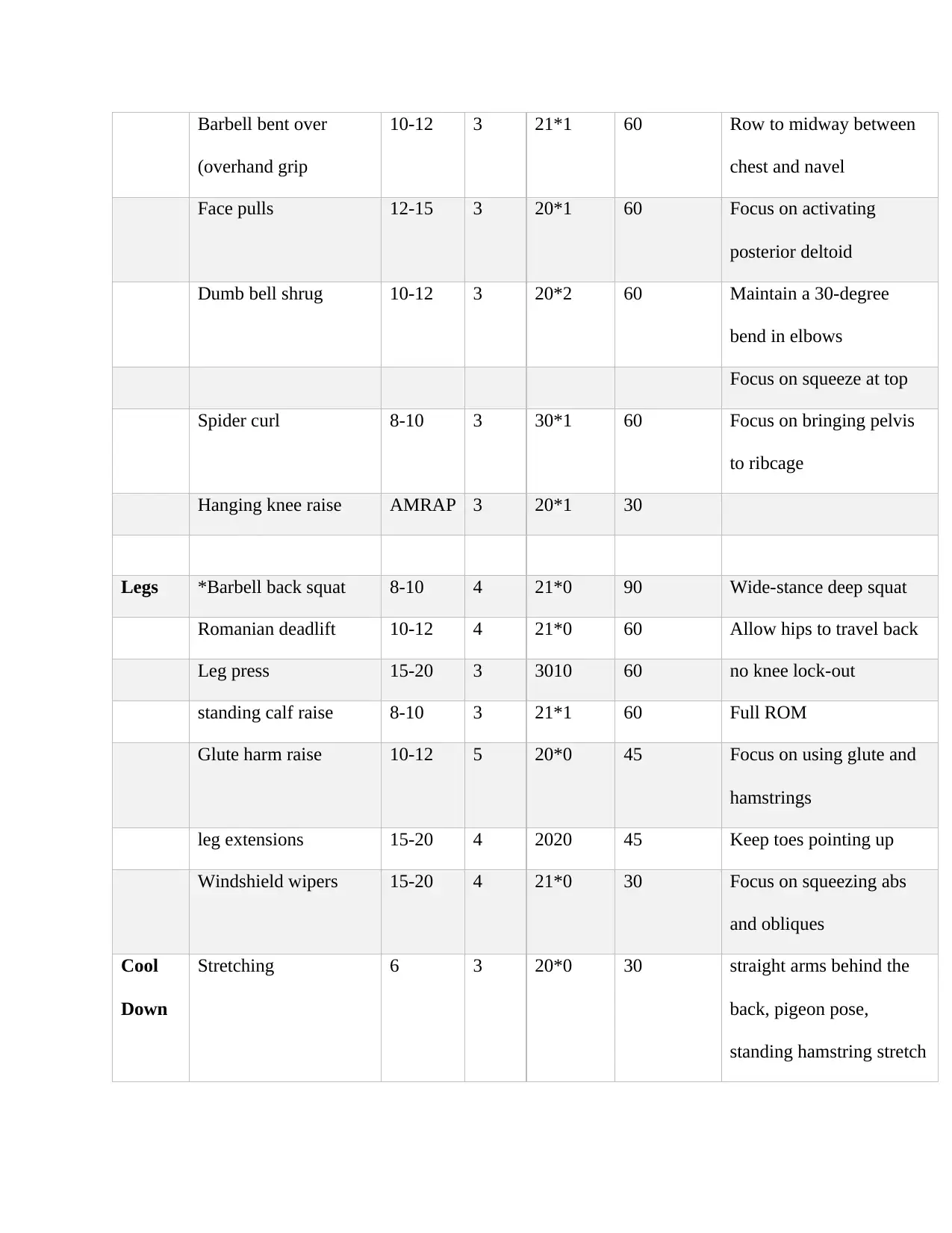
Barbell bent over
(overhand grip
10-12 3 21*1 60 Row to midway between
chest and navel
Face pulls 12-15 3 20*1 60 Focus on activating
posterior deltoid
Dumb bell shrug 10-12 3 20*2 60 Maintain a 30-degree
bend in elbows
Focus on squeeze at top
Spider curl 8-10 3 30*1 60 Focus on bringing pelvis
to ribcage
Hanging knee raise AMRAP 3 20*1 30
Legs *Barbell back squat 8-10 4 21*0 90 Wide-stance deep squat
Romanian deadlift 10-12 4 21*0 60 Allow hips to travel back
Leg press 15-20 3 3010 60 no knee lock-out
standing calf raise 8-10 3 21*1 60 Full ROM
Glute harm raise 10-12 5 20*0 45 Focus on using glute and
hamstrings
leg extensions 15-20 4 2020 45 Keep toes pointing up
Windshield wipers 15-20 4 21*0 30 Focus on squeezing abs
and obliques
Cool
Down
Stretching 6 3 20*0 30 straight arms behind the
back, pigeon pose,
standing hamstring stretch
(overhand grip
10-12 3 21*1 60 Row to midway between
chest and navel
Face pulls 12-15 3 20*1 60 Focus on activating
posterior deltoid
Dumb bell shrug 10-12 3 20*2 60 Maintain a 30-degree
bend in elbows
Focus on squeeze at top
Spider curl 8-10 3 30*1 60 Focus on bringing pelvis
to ribcage
Hanging knee raise AMRAP 3 20*1 30
Legs *Barbell back squat 8-10 4 21*0 90 Wide-stance deep squat
Romanian deadlift 10-12 4 21*0 60 Allow hips to travel back
Leg press 15-20 3 3010 60 no knee lock-out
standing calf raise 8-10 3 21*1 60 Full ROM
Glute harm raise 10-12 5 20*0 45 Focus on using glute and
hamstrings
leg extensions 15-20 4 2020 45 Keep toes pointing up
Windshield wipers 15-20 4 21*0 30 Focus on squeezing abs
and obliques
Cool
Down
Stretching 6 3 20*0 30 straight arms behind the
back, pigeon pose,
standing hamstring stretch
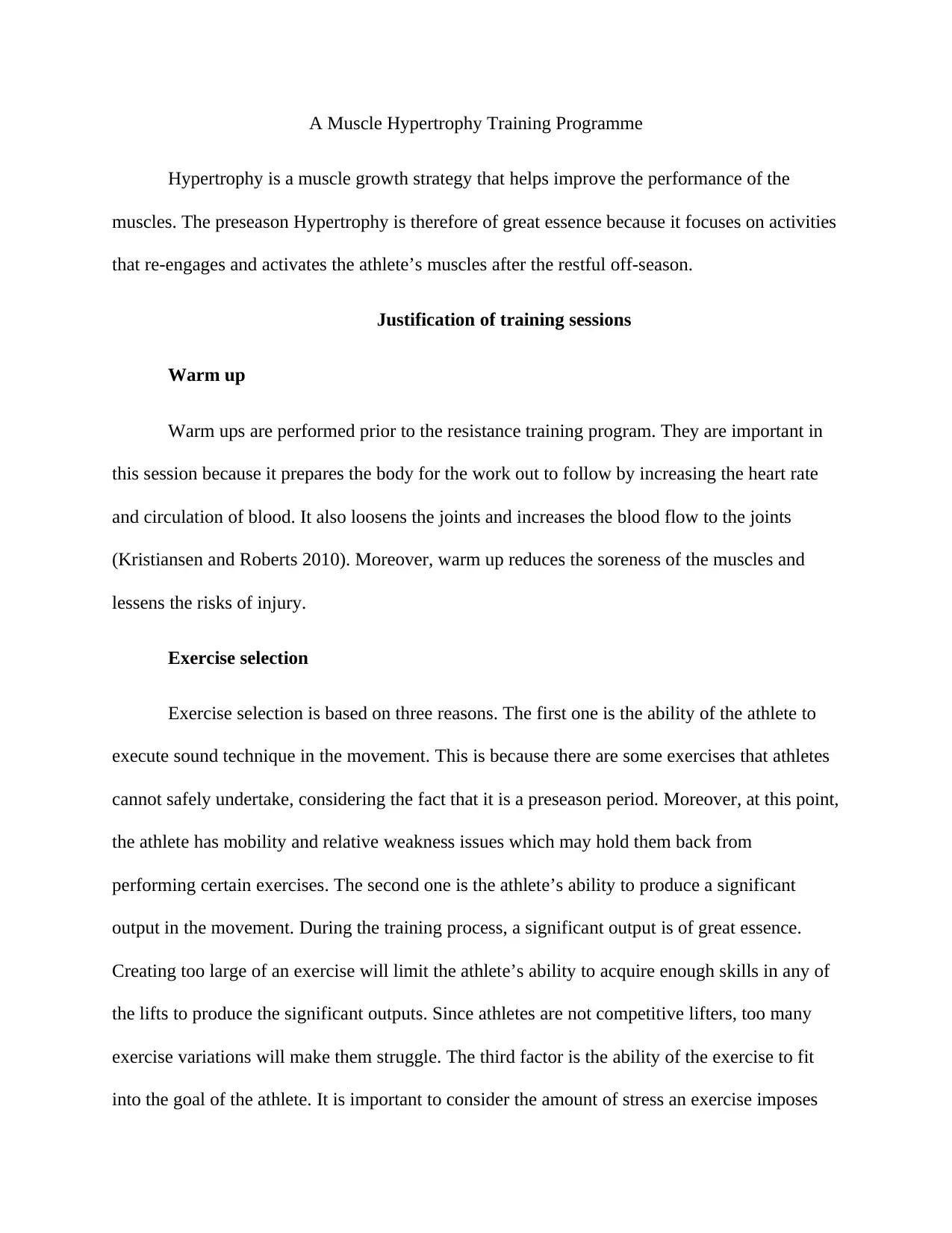
A Muscle Hypertrophy Training Programme
Hypertrophy is a muscle growth strategy that helps improve the performance of the
muscles. The preseason Hypertrophy is therefore of great essence because it focuses on activities
that re-engages and activates the athlete’s muscles after the restful off-season.
Justification of training sessions
Warm up
Warm ups are performed prior to the resistance training program. They are important in
this session because it prepares the body for the work out to follow by increasing the heart rate
and circulation of blood. It also loosens the joints and increases the blood flow to the joints
(Kristiansen and Roberts 2010). Moreover, warm up reduces the soreness of the muscles and
lessens the risks of injury.
Exercise selection
Exercise selection is based on three reasons. The first one is the ability of the athlete to
execute sound technique in the movement. This is because there are some exercises that athletes
cannot safely undertake, considering the fact that it is a preseason period. Moreover, at this point,
the athlete has mobility and relative weakness issues which may hold them back from
performing certain exercises. The second one is the athlete’s ability to produce a significant
output in the movement. During the training process, a significant output is of great essence.
Creating too large of an exercise will limit the athlete’s ability to acquire enough skills in any of
the lifts to produce the significant outputs. Since athletes are not competitive lifters, too many
exercise variations will make them struggle. The third factor is the ability of the exercise to fit
into the goal of the athlete. It is important to consider the amount of stress an exercise imposes
Hypertrophy is a muscle growth strategy that helps improve the performance of the
muscles. The preseason Hypertrophy is therefore of great essence because it focuses on activities
that re-engages and activates the athlete’s muscles after the restful off-season.
Justification of training sessions
Warm up
Warm ups are performed prior to the resistance training program. They are important in
this session because it prepares the body for the work out to follow by increasing the heart rate
and circulation of blood. It also loosens the joints and increases the blood flow to the joints
(Kristiansen and Roberts 2010). Moreover, warm up reduces the soreness of the muscles and
lessens the risks of injury.
Exercise selection
Exercise selection is based on three reasons. The first one is the ability of the athlete to
execute sound technique in the movement. This is because there are some exercises that athletes
cannot safely undertake, considering the fact that it is a preseason period. Moreover, at this point,
the athlete has mobility and relative weakness issues which may hold them back from
performing certain exercises. The second one is the athlete’s ability to produce a significant
output in the movement. During the training process, a significant output is of great essence.
Creating too large of an exercise will limit the athlete’s ability to acquire enough skills in any of
the lifts to produce the significant outputs. Since athletes are not competitive lifters, too many
exercise variations will make them struggle. The third factor is the ability of the exercise to fit
into the goal of the athlete. It is important to consider the amount of stress an exercise imposes

on an athlete verses the benefit it has to development of the athlete. It is important to choose low
cost exercises that adds extra benefit to the performance of the athlete.
Exercise order
The order of exercises is in accordance with the goals of the athlete. The exercise order is
based on the available energy for performing the exercise, the causes of muscle fatigue, as well
as the risk of injury. According to Nazari, Azarbayjani, and Azizbeigi (2016), doing cardio
before weightlifting may injure the muscles and render them ineffective. This explains the
importance of exercise order.
Exercise Volume
Exercise volume is the most important aspect of training in athletes as it must be
increased over and over. The exercise volume includes the amount of sets and preps that the
athlete will be doing in each workout. It is also involving weight. However, too much of volume
may lead to injury while too little may result into stagnation. According to Aengevaeren et al.
(2017), higher volumes of exercise may result into coronary atherosclerosis. The exercise
volume in this program is therefore moderate and in accordance with a preseason athlete’s
requirements.
Exercise intensity
The exercise intensity is the overall physical output and strain on the body during a
training session. In this program, the intensity was dictated by the amount of lifted weight and
the exercises selected. Haddad et al. (2014) argue that the time spent on exercise intensity has an
influence on the rating of the perceived exertion that has been referred to the whole training
cost exercises that adds extra benefit to the performance of the athlete.
Exercise order
The order of exercises is in accordance with the goals of the athlete. The exercise order is
based on the available energy for performing the exercise, the causes of muscle fatigue, as well
as the risk of injury. According to Nazari, Azarbayjani, and Azizbeigi (2016), doing cardio
before weightlifting may injure the muscles and render them ineffective. This explains the
importance of exercise order.
Exercise Volume
Exercise volume is the most important aspect of training in athletes as it must be
increased over and over. The exercise volume includes the amount of sets and preps that the
athlete will be doing in each workout. It is also involving weight. However, too much of volume
may lead to injury while too little may result into stagnation. According to Aengevaeren et al.
(2017), higher volumes of exercise may result into coronary atherosclerosis. The exercise
volume in this program is therefore moderate and in accordance with a preseason athlete’s
requirements.
Exercise intensity
The exercise intensity is the overall physical output and strain on the body during a
training session. In this program, the intensity was dictated by the amount of lifted weight and
the exercises selected. Haddad et al. (2014) argue that the time spent on exercise intensity has an
influence on the rating of the perceived exertion that has been referred to the whole training
Secure Best Marks with AI Grader
Need help grading? Try our AI Grader for instant feedback on your assignments.
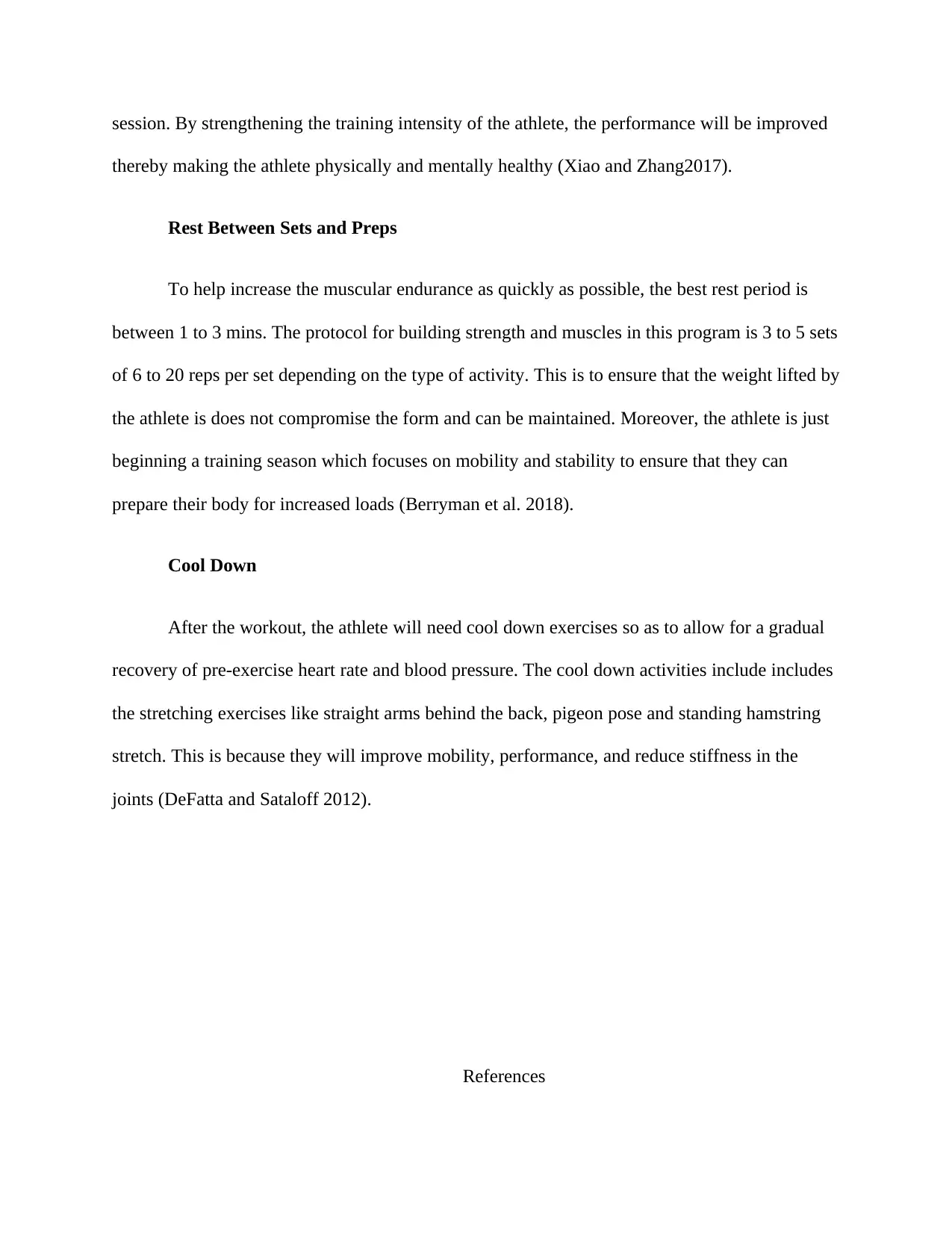
session. By strengthening the training intensity of the athlete, the performance will be improved
thereby making the athlete physically and mentally healthy (Xiao and Zhang2017).
Rest Between Sets and Preps
To help increase the muscular endurance as quickly as possible, the best rest period is
between 1 to 3 mins. The protocol for building strength and muscles in this program is 3 to 5 sets
of 6 to 20 reps per set depending on the type of activity. This is to ensure that the weight lifted by
the athlete is does not compromise the form and can be maintained. Moreover, the athlete is just
beginning a training season which focuses on mobility and stability to ensure that they can
prepare their body for increased loads (Berryman et al. 2018).
Cool Down
After the workout, the athlete will need cool down exercises so as to allow for a gradual
recovery of pre-exercise heart rate and blood pressure. The cool down activities include includes
the stretching exercises like straight arms behind the back, pigeon pose and standing hamstring
stretch. This is because they will improve mobility, performance, and reduce stiffness in the
joints (DeFatta and Sataloff 2012).
References
thereby making the athlete physically and mentally healthy (Xiao and Zhang2017).
Rest Between Sets and Preps
To help increase the muscular endurance as quickly as possible, the best rest period is
between 1 to 3 mins. The protocol for building strength and muscles in this program is 3 to 5 sets
of 6 to 20 reps per set depending on the type of activity. This is to ensure that the weight lifted by
the athlete is does not compromise the form and can be maintained. Moreover, the athlete is just
beginning a training season which focuses on mobility and stability to ensure that they can
prepare their body for increased loads (Berryman et al. 2018).
Cool Down
After the workout, the athlete will need cool down exercises so as to allow for a gradual
recovery of pre-exercise heart rate and blood pressure. The cool down activities include includes
the stretching exercises like straight arms behind the back, pigeon pose and standing hamstring
stretch. This is because they will improve mobility, performance, and reduce stiffness in the
joints (DeFatta and Sataloff 2012).
References
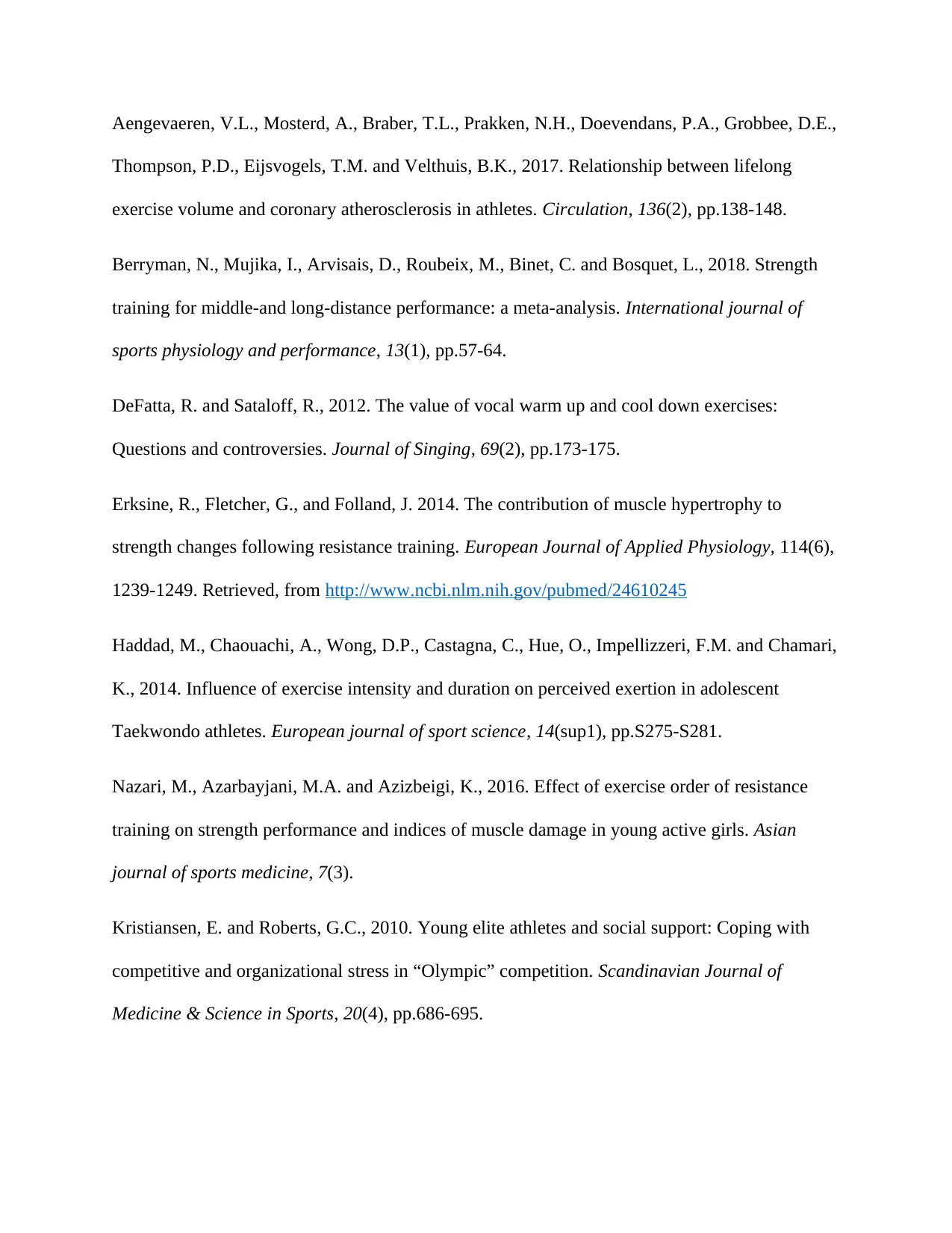
Aengevaeren, V.L., Mosterd, A., Braber, T.L., Prakken, N.H., Doevendans, P.A., Grobbee, D.E.,
Thompson, P.D., Eijsvogels, T.M. and Velthuis, B.K., 2017. Relationship between lifelong
exercise volume and coronary atherosclerosis in athletes. Circulation, 136(2), pp.138-148.
Berryman, N., Mujika, I., Arvisais, D., Roubeix, M., Binet, C. and Bosquet, L., 2018. Strength
training for middle-and long-distance performance: a meta-analysis. International journal of
sports physiology and performance, 13(1), pp.57-64.
DeFatta, R. and Sataloff, R., 2012. The value of vocal warm up and cool down exercises:
Questions and controversies. Journal of Singing, 69(2), pp.173-175.
Erksine, R., Fletcher, G., and Folland, J. 2014. The contribution of muscle hypertrophy to
strength changes following resistance training. European Journal of Applied Physiology, 114(6),
1239-1249. Retrieved, from http://www.ncbi.nlm.nih.gov/pubmed/24610245
Haddad, M., Chaouachi, A., Wong, D.P., Castagna, C., Hue, O., Impellizzeri, F.M. and Chamari,
K., 2014. Influence of exercise intensity and duration on perceived exertion in adolescent
Taekwondo athletes. European journal of sport science, 14(sup1), pp.S275-S281.
Nazari, M., Azarbayjani, M.A. and Azizbeigi, K., 2016. Effect of exercise order of resistance
training on strength performance and indices of muscle damage in young active girls. Asian
journal of sports medicine, 7(3).
Kristiansen, E. and Roberts, G.C., 2010. Young elite athletes and social support: Coping with
competitive and organizational stress in “Olympic” competition. Scandinavian Journal of
Medicine & Science in Sports, 20(4), pp.686-695.
Thompson, P.D., Eijsvogels, T.M. and Velthuis, B.K., 2017. Relationship between lifelong
exercise volume and coronary atherosclerosis in athletes. Circulation, 136(2), pp.138-148.
Berryman, N., Mujika, I., Arvisais, D., Roubeix, M., Binet, C. and Bosquet, L., 2018. Strength
training for middle-and long-distance performance: a meta-analysis. International journal of
sports physiology and performance, 13(1), pp.57-64.
DeFatta, R. and Sataloff, R., 2012. The value of vocal warm up and cool down exercises:
Questions and controversies. Journal of Singing, 69(2), pp.173-175.
Erksine, R., Fletcher, G., and Folland, J. 2014. The contribution of muscle hypertrophy to
strength changes following resistance training. European Journal of Applied Physiology, 114(6),
1239-1249. Retrieved, from http://www.ncbi.nlm.nih.gov/pubmed/24610245
Haddad, M., Chaouachi, A., Wong, D.P., Castagna, C., Hue, O., Impellizzeri, F.M. and Chamari,
K., 2014. Influence of exercise intensity and duration on perceived exertion in adolescent
Taekwondo athletes. European journal of sport science, 14(sup1), pp.S275-S281.
Nazari, M., Azarbayjani, M.A. and Azizbeigi, K., 2016. Effect of exercise order of resistance
training on strength performance and indices of muscle damage in young active girls. Asian
journal of sports medicine, 7(3).
Kristiansen, E. and Roberts, G.C., 2010. Young elite athletes and social support: Coping with
competitive and organizational stress in “Olympic” competition. Scandinavian Journal of
Medicine & Science in Sports, 20(4), pp.686-695.

Xiao, T. and Zhang, Y., 2017. Correlation between athlete training intensity and cardiac
performance. Nigerian journal of clinical practice, 20(2), pp.248-251.
performance. Nigerian journal of clinical practice, 20(2), pp.248-251.
1 out of 7
Your All-in-One AI-Powered Toolkit for Academic Success.
+13062052269
info@desklib.com
Available 24*7 on WhatsApp / Email
![[object Object]](/_next/static/media/star-bottom.7253800d.svg)
Unlock your academic potential
© 2024 | Zucol Services PVT LTD | All rights reserved.